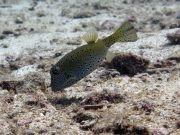Dykning med Kassefisk
Koh Lantas Marineliv | Ostraciidae
Kassefisk er, som navnet antyder, kasseformede med en pansret og stiv krop, som i de fleste tilfælde ville hæmme bevægeligheden. Denne ulempe opvejes af kassefiskens form, som har ført til udviklingen af en usædvanlig svømmestil.
De ses ofte på sandbund eller murbrokker tæt på revkanten på dykkerture ved Koh Lanta.
Kassefisk er normalt ensomme dyr, der samles om foråret i små grupper bestående af 1 han og 2-4 hunner for at yngle.
Alle dokumenterede arter af kassefisk anvender en gydeopstigningsstrategi. Ved solnedgang eller solopgang bruger hannen sin tid på at blinke med lyse farver og danse omkring hunnen. Når hunnen er tilfreds, svømmer hun hurtigt op til overfladen eller til lavt åbent vand (opstigningen), og hannen brummer derefter til hunnen, højt nok til at en dykker kan høre det. Æggene befrugtes og frigives, og kassefiskene vender tilbage til sikrere, beskyttede og beskyttede dele af revet.
Denne pelagiske gydeteknik betyder, at når æggene er udklækket, spredes de kraftigt af strømmen ud i det åbne hav. Hunnen kan producere et antal æg dagligt i omkring en måned. En fordel ved denne teknik er, at rovdyr ikke kan æde hele æggekullen, men chancerne for, at et udklækket æg driver til et passende tilflugtssted, hvor en nyfødt kan leve og overleve, er små, hvilket fører til en høj dødelighed i reproduktionen af kassefisk.
3 arter fundet på denne side:
Yellow Boxfish
(Ostracion cubicus)
The Yellow Boxfish (Ostracion cubicus) is a species of boxfish found in relative shallow waters, usually among corals and complex structures which can provide protection from potential predators.
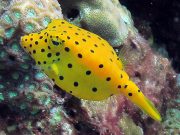
Ostracion cubicus @ Koh Haa
When juvenile, the Yellow Boxfish is bright yellow in color with black spots, and easy to identify. As they begin to mature the number of spots decreases and the yellow blends into almost a dirty, mustard colour.
Very old specimens will have blue-grey to black colouration with faded yellow. As they grow, the body elongates and a bump forms on the snout tip.
Juvenile - Bright yellow with black spots on head and body. Possibly starting to grow a small bump on snout tip.
Young Adult - Yellowish brown to olive coloured, with black spots on the head and a few dark ringed bluish spots on the body. Young adults will have a small bump on the snout tip.
Intermediate Adult - Tan to yellowish brown colour with dark ringed bluish spots. Fins are blue with black spots and may have blue/black or yellow crinkled line markings on the head and base of the pectoral fins. Obvious bump on the snout tip.
Large Adult - Brownish purplish or blue/greyish with indistinct/faded spots. Often yellow crinkled line markings on the head and yellowish tail base. Bump on the snout tip. Can reach a maximum length of 45 centimetres (18 in).
The Yellow Boxfish feeds mainly on algae, but will also feed on sponges, crustaceans and molluscs. The fish's diet consists of marine algae, worms, crustaceans, molluscs, and small fish. Using its puckered lips, it blows small bursts of water at the corals and sand to reveal anything that might be hiding.
When stressed or injured the Yellow Boxfish releases the neurotoxin tetrodoxin (TTX) from special cells covering their entire skin. This cloud of poison can be fatal to fish in the surrounding waters. The bright yellow colour and black spots are also a form of warning coloration (Aposematism) to any potential predators.
Horn-nosed Boxfish
(Ostracion rhinorhynchos)
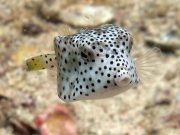
Ostracion rhinorhynchos @ Koh Bida
The Horn-nose Boxfish has a carapace that is pentagonal (six sides) in cross-section. The body ridges are relatively sharp-edged, and lack spines. There is a distinct bump on snout.
This species is whitish with black spots on the back and caudal peduncle. Large fish are darker with more dark spots.
This is a generally uncommon species and is found singly or in pairs over channels, coral patches and rubble substrates of sandy lagoons and sheltered inner reefs.
Feeds on benthic invertebrates.
Whitespotted Boxfish
(Ostracion meleagris)
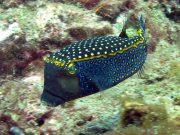
Male Ostracion meleagris @ Koh Bida
The male Whitespotted Boxfish has a black back with white spots and blue sides with bright yellow spots and bands.
Female and juvenile Whitespotted Boxfish have a black or dark brown body with white spots.
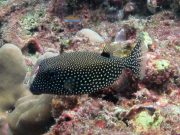
Female Ostracion meleagris @ Koh Haa
The Whitespotted Boxfish grows to 25 cm. The diet includes molluscs, bristle worms, sponges, crustaceans and algae.
Dykning med Kassefisk omkring Koh Lanta
Dykning og snorkelture
Hvis du gerne vil have chancen for at se Kassefisk på en af vores daglige dykkerture i højsæsonen fra Koh Lanta, så send os en e-mail til info@diveandrelax.com.
Deltag i vores speedbådsdykkerture i højsæsonen til nogle af Thailands bedste dykkersteder og nyd små grupper, korte rejsetider med fokus på god personlig service, sikkerhed og sjov.
Er du endnu ikke certificeret dykker? Lær at dykke på Koh Lanta med det 3-dages SSI Open Water Diver-kursus.
Book online og spar 10% på dykkerture og dykkerkurser på Koh Lanta.
Få mere at vide
Indo-Stillehavets havdyrsguider
- Allen, G., Steene, R., Humann, P., DeLoach, N. (2003) Reef Fish Identification, Tropical Pacific. Jacksonville, FL., USA: New World Publications, Inc., ISBN 1-878348-36-1.
- Humann, P., DeLoach, N., (2010) Reef Creature Identification, Tropical Pacific. Jacksonville, FL., USA: New World Publications Inc., ISBN 978-1-878348-44-9
- Debelius, H. (2013) Indian Ocean Reef Guide. Frankfurt, Germany: IKAN - Unterwasserarchiv, ISBN 978-3-939767-52-7.
- Debelius, H. (2004) Nudibranchs and Sea Snails, Indo-Pacific Field Guide. Frankfurt, Germany: IKAN - Unterwasserarchiv, ISBN 3-925919-51-1
- Erhardt, H., Knop, D. (2015) Corals Indo-Pacific Field Guide. Frankfurt, Germany: IKAN - Unterwasserarchiv, ISBN 3-925919-69-4.
- Veron J.E.N., Stafford-Smith M.G., Turak E. and DeVantier L.M. (2016). Corals of the World
Flere referencer om havets dyreliv og yderligere information


